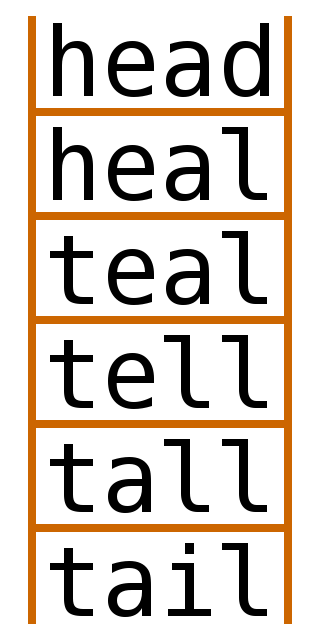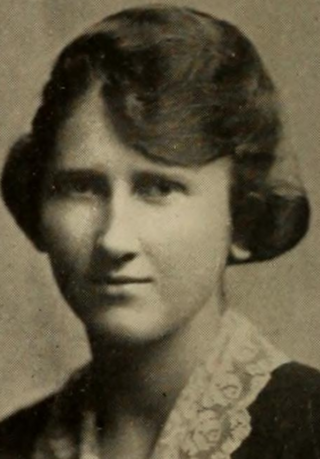Word games are spoken, board, card or video games often designed to test ability with language or to explore its properties.

William Shunn is an American science fiction writer and computer programmer. He was raised in a Latter-day Saint household, the oldest of eight children. In 1986, he served a mission to Canada for the Church of Jesus Christ of Latter-day Saints, but was arrested for making a false bomb threat, for the purpose of preventing his fellow missionary from returning home.

William F. Shortz is an American puzzle creator and editor who is the crossword editor for The New York Times. He graduated from Indiana University with a degree in the invented field of enigmatology. After starting his career at Penny Press and Games magazine, he was hired by The New York Times in 1993. Shortz's American Crossword Puzzle Tournament is the country's oldest and largest crossword tournament.

Word ladder is a word game invented by Lewis Carroll. A word ladder puzzle begins with two words, and to solve the puzzle one must find a chain of other words to link the two, in which two adjacent words differ by one letter.

The New York Times Crossword is a daily American-style crossword puzzle published in The New York Times as part of The New York Times Games, online on the newspaper's website, syndicated to more than 300 other newspapers and journals, and on mobile apps.
Crosswordese is the group of words frequently found in US crossword puzzles but seldom found in everyday conversation. The words are usually short, three to five letters, with letter combinations which crossword constructors find useful in the creation of crossword puzzles, such as words that start and/or end with vowels, abbreviations consisting entirely of consonants, unusual combinations of letters, and words consisting almost entirely of frequently used letters. Such words are needed in almost every puzzle to some extent. Too much crosswordese in a crossword puzzle is frowned upon by crossword-makers and crossword enthusiasts.

Margaret Petherbridge Farrar was an American journalist and the first crossword puzzle editor for The New York Times (1942–1968). Creator of many of the rules of modern crossword design, she compiled and edited a long-running series of crossword puzzle books – including the first book of any kind that Simon & Schuster published (1924). She was considered "the grand dame of the American crossword puzzle."
Deb Amlen is a humor writer and crossword puzzle constructor whose work has been featured in The New York Times, The Washington Post, Los Angeles Times, and other national publications.

David Kwong is a magician, puzzle creator, writer, and producer.

Joel Fagliano is an American puzzle creator. He is known for his work at The New York Times, where he writes the paper's Mini Crossword. On March 14, 2024, Fagliano became the interim editor of The New York Times Crossword due to editor Will Shortz being on medical leave.
Frank Longo is an American puzzle creator, and author of over 90 books, which have sold over 2 million copies.
Wordle is a web-based word game created and developed by Welsh software engineer Josh Wardle. Players have six attempts to guess a five-letter word, with feedback given for each guess in the form of coloured tiles indicating when letters match or occupy the correct position. The mechanics are similar to the 1955 pen-and-paper game Jotto and the television game show franchise Lingo. Wordle has a single daily solution, with all players attempting to guess the same word.
Josh Wardle is a Welsh software engineer who developed the viral web-based word game Wordle. The New York Times Company acquired Wordle from Wardle in late January 2022. Wardle lives in Brooklyn, New York.

Connections is a word puzzle developed and published by The New York Times as part of The New York Times Games. It was released for PC on June 12, 2023, during its beta phase. It is the second most played game that is published by Times, behind Wordle.

Andrea Carla Michaels is an American crossword puzzle constructor and corporate naming consultant. She was a comedian and television writer after graduating from Harvard University in 1980 and has played competitive chess and Scrabble and appeared on Jeopardy! and Wheel of Fortune. More than 80 crosswords by her have been published in The New York Times since 2000. In San Francisco, she has become known as the "Pizza Lady" for her efforts to feed homeless people in her community.

Wyna Liu is an American puzzle creator and editor of the New York Times game Connections.
Tracy Bennett is an American editor and puzzle editor. She edits The New York Times Games products Wordle and Strands.

Letter Boxed is a online word puzzle video game created by Sam Ezersky and published in 2019 on The New York Times Games. It was the third game published in the puzzles section on the New York Times website after the Crossword and Spelling Bee. Originally created as part of an effort to attract new subscribers, Letter Boxed is one of a suite of casual games that has become an important revenue driver for the company, and for which "The New York Times has attained the reputation for having fun, quick and easy daily games."

The New York Times Games is a collection of casual print and online games published by The New York Times, an American newspaper. Originated with the crossword in 1942, NYT Games was officially established on August 21, 2014, with the addition of the Mini Crossword. Most puzzles of The New York Times Games are published and refreshed daily, mirroring The Times' daily newspaper cadence.

Strands is an online word game created by The New York Times. Released into beta in March 2024, Strands is a part of the New York Times Games library. Strands takes the form of a word search, with new puzzles released once every day. The original pitch for the game was created by Juliette Seive, and puzzles are edited by Tracy Bennett.














